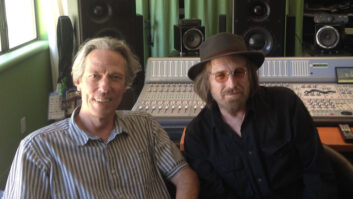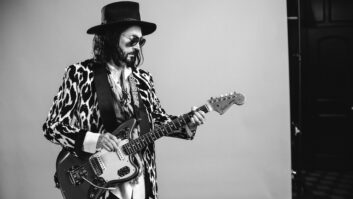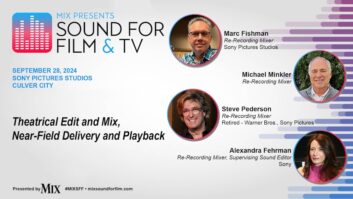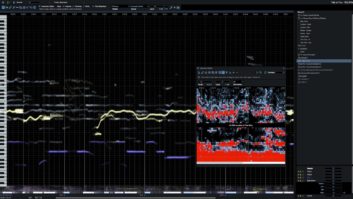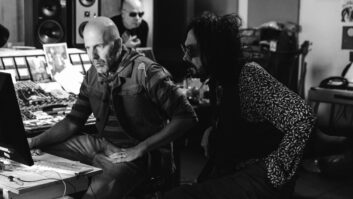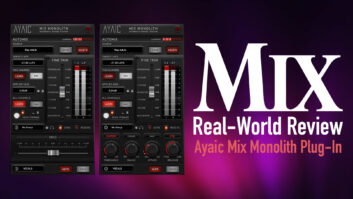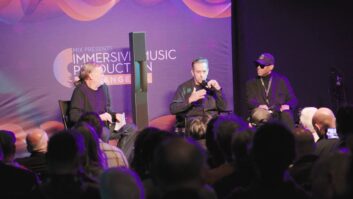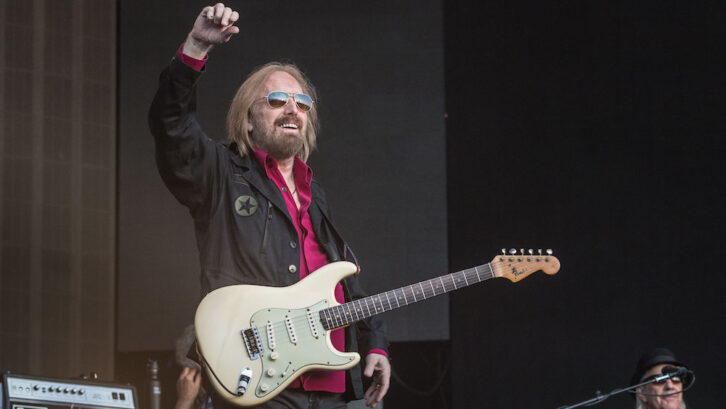
RE-MIX is an ongoing series of vintage articles rediscovered from the pages of Mix magazine. This in-depth interview with Tom Petty originally appeared in the March, 1994 issue of Mix as “Tom Petty: History In The Hits,” with the legendary rocker recounting how some of his most important songs came to hit tape. For the latest from the article’s author, Mr. Bonzai, check out www.mrbonzai.com.

“I guess people usually put out a hits collection before 18 years go by,” Tom Petty admits modestly, “but I just never thought about it before.”
The Tom Petty musical saga started back in his hometown of Gainesville, Fla., when he teamed up with guitarist Mike Campbell and keyboardist Benmont Tench to form a band called Mudcrutch. The band got a record deal, moved to Los Angeles in 1974, their first single flopped, and the group disbanded. Two years later they were joined by fellow Floridians Stan Lynch on drums and Ron Blair on bass, and Tom Petty & The Heartbreakers were born.
Luck was with them this time around. The big break for The Heartbreakers was a radio-friendly song called “American Girl,” which was described as “Byrds-like” at the time and even recorded by Roger McGuinn. “Breakdown,” also from their first Shelter Records album, was their first to crack the Top 40. The band toured unceasingly in the late ’70s, successfully bridging the gap between the burgeoning new wave and the pop mainstream. It was melodic rock, but with some attitude.
In 1979, The Heartbreakers, with Blair replaced by Howie Epstein on bass, began work with producer Jimmy lovine and ace engineer Shelly Yakus and scored big hits with “Don’t Do Me Like That” and “Refugee.” “We started to get a much bigger sound on the records,” Petty says. “It was certainly a turning point production-wise.”
In 1982, the band recorded “You Got Lucky” and made a landmark music video, known as a “promo clip” at the time. Shot in the desert with a futuristic Western motif, it was released just as MTV was being born—indeed, The Heartbreakers were one of the earliest bands to benefit from heavy MTV play.
In 1985, Dave Stewart of Eurythmics entered the picture as co-producer of “Don’t Come Around Here No More.’ Petty describes it as one of his favorite singles, “with all sorts of strange sounds, and a pretty wild arrangement—a first sign of breaking ground and finding new things musically!”
Working with Mike Campbell, Petty’s solo album Full Moon Fever hit in 1989, produced by Jeff Lynne (a fellow Traveling Wilbury along with Bob Dylan, George Harrison, and Roy Orbison).
From The Heartbreakers’ most recent album, Into the Great Wide Open, the hits package includes the title track and the enchanting “Learning to Fly.” Of the two bonus tracks produced by Rick Rubin, Petty says, “He brought us back to a sense of freedom—nothing is too outrageous, we can try anything, and it’s evaluated for what it is.”
Our conversation took place just as the Greatest Hits album was completed and as Petty was in the final stages of preparing a Disney Channel rockumentary of his career, directed by Jon Bendis.
Bonzai: Any surprises for you in going over the old film footage?
Petty: I was surprised that the music held up as well as it did—performances that I thought might not be my favorites, in retrospect, seeing them 18 years later, they’re pretty damn good. It was kind of fun watching it, actually.
Bonzai: How have your songs changed over the years thematically?
Petty: Well, I think the songs have certainly grown in a lot of ways. Lyrically, I’ve certainly gotten better. I think I’ve gotten better musically overall, although I still do enjoy that wild rock ‘n’ roll stuff. In a way, I think that’s where I’m headed again.
Bonzai: How have the changes in recording technology affected your work over the years?
Petty: Well, to my knowledge, the changes in recording technology have really screwed up music for the most part. I spend an inordinate amount of money to stay away from any sort of technology.
Bonzai: I’m not sure I understand—you spend the money to stay away from it?
Petty: Yes, because it’s getting more and more expensive to buy this old ’60s gear. We won’t allow any computer of any kind in the room at any stage of the game, or any sampling, synthesizer, or anything. I really like the sounds that you get through cheaper equipment.
Actually, last week we were mixing, and I went to three studios and ended up going back to Mike Campbell’s house and mixing on his Soundcraft desk because I didn’t like any of the multi-million-dollar desks I was working on. They just put too much gear in there, too much stuff that you don’t need that really colors your sound. I’ve got the sound I want on the tape—I don’t really want another sound coming up through the board.
Bonzai: You’ve known Mike Campbell since you were teenagers?
Petty: Yes, we met in 1970.
Bonzai: How do a friendship and an artistic relationship last so long?
Petty: Well, I guess we just really hit it off. He’s a brilliant player, and I think we shared a lot of the same interests. We were the same age and were interested in the same kinds of music. Ever since I was about 11 years old, I’ve never quite been with my own age group in what I liked musically. I was more hung up on the music of the ’50s when I really shouldn’t have been, but that was what really spoke to me—’50s rock ‘n’ roll. And Michael could understand that and really dug that.
Then we both embraced the ’60s at the same time, but our roots are deep in rockabilly and the music of the ’50s and early ’60s. We’ve tried to assimilate everything else that has come along, and we’ve just gotten along very well. I’ve known Ben [Tench] longer than I have Michael, and Stan [ Lynch] I think I met the following year, 1971. So, it’s a long time to be together. They’re sort of like your brothers—you love ’em and you hate ’em. [Laughs]
Hunting for Tom Petty’s “American Treasure”
Bonzai: Let’s talk about the songs on this Greatest Hits album—”American Girl”?
Petty: It was our first single, 1976. We were quite surprised when it came out, when we started reading that it sounded like The Byrds. We were huge Byrds fans, but we had never dreamed that we would sound like them. But I guess it did sound like The Byrds because Roger thought it was him when he heard it.
I was immediately summoned over to see Roger McGuinn, at the time, which made me very nervous because I wasn’t sure what it was about. But he turned out to be a lovely guy, and he invited us to go on tour with him, which we did. Sometimes we would do two shows a night with both bands playing “American Girl,” so it would get played four times in an evening.
Bonzai: “Breakdown”?
Petty: Well, that was in the same year, and I think it’s still a very popular number. We don’t play it any more in concerts, but they still yell for it all night. [Laughs]
Bonzai: “Listen to Her Heart”?
Petty: One of my favorites, from the next album. Again, it’s very Byrds-like. It had the controversial cocaine line at the time. [“You think you’re gonna take her away, with your money and your cocaine.”]
They didn’t want me to say the word ‘cocaine’. they wanted me to say champagne. I thought that it wasn’t fair, because there was such a huge difference in what I was talking about. It was inspired by a near-horrifying experience.
Bonzai: “I Need to Know,” 1978.
Petty: A very fast one, inspired by Wilson Pickett’s “Land of a Thousand Dances:’ He’s one of my all time favorites—I love Wilson Pickett. I could play his greatest hits album all day long.
Bonzai: “Refugee,” 1979.
Petty: That was one of the first things I did after meeting Jimmy Iovine and Shelly Yakus. They came out from New York, and it was one of the first things we cut.
Bonzai: Was that a turning point for you musically?
Petty: I don’t know if it was at urning point musically. We learned more about recording at that point, and we started to take a lot more time in the studio than we’d had the luxury to do before.
Bonzai: “Don’t Do Me Like That,” 1979.
Petty: That was a song that almost didn’t get on that album. It was one that we did in Mudcrutch, actually. We played it one day, and I was sort of tired of it, and I thought it wasn’t right for what we were doing at the time.
The assistant engineer, Tory Swinson, suggested at the very last minute that we please get that tape out and play it again because he thought it was great. So we played it again, liked it, and we put it on the album, and then it was a hit. So, you never know. It was an R&B kinda song, you know?
Bonzai: “Even the Losers”…get lucky sometimes.
Petty: That was one of my particular favorites from that album. Just lucky, really. I remember sort of writing it, and I think I actually finished it in the studio as we were cutting the track. I was still trying to fill in words, and it was a great feeling when they played it back and all the words were there. [Laughs]
Bonzai: Do you work well under pressure?
Petty: Well, I don’t like to think so, but I probably do. I know that a lot of the songs were written in the studio. I wrote “Breakdown” while the band was playing cards in the other room, waiting on a song to cut. [Laughs] But I prefer not to do that if I can get around it. I’d much rather have the song all done before I come in.
